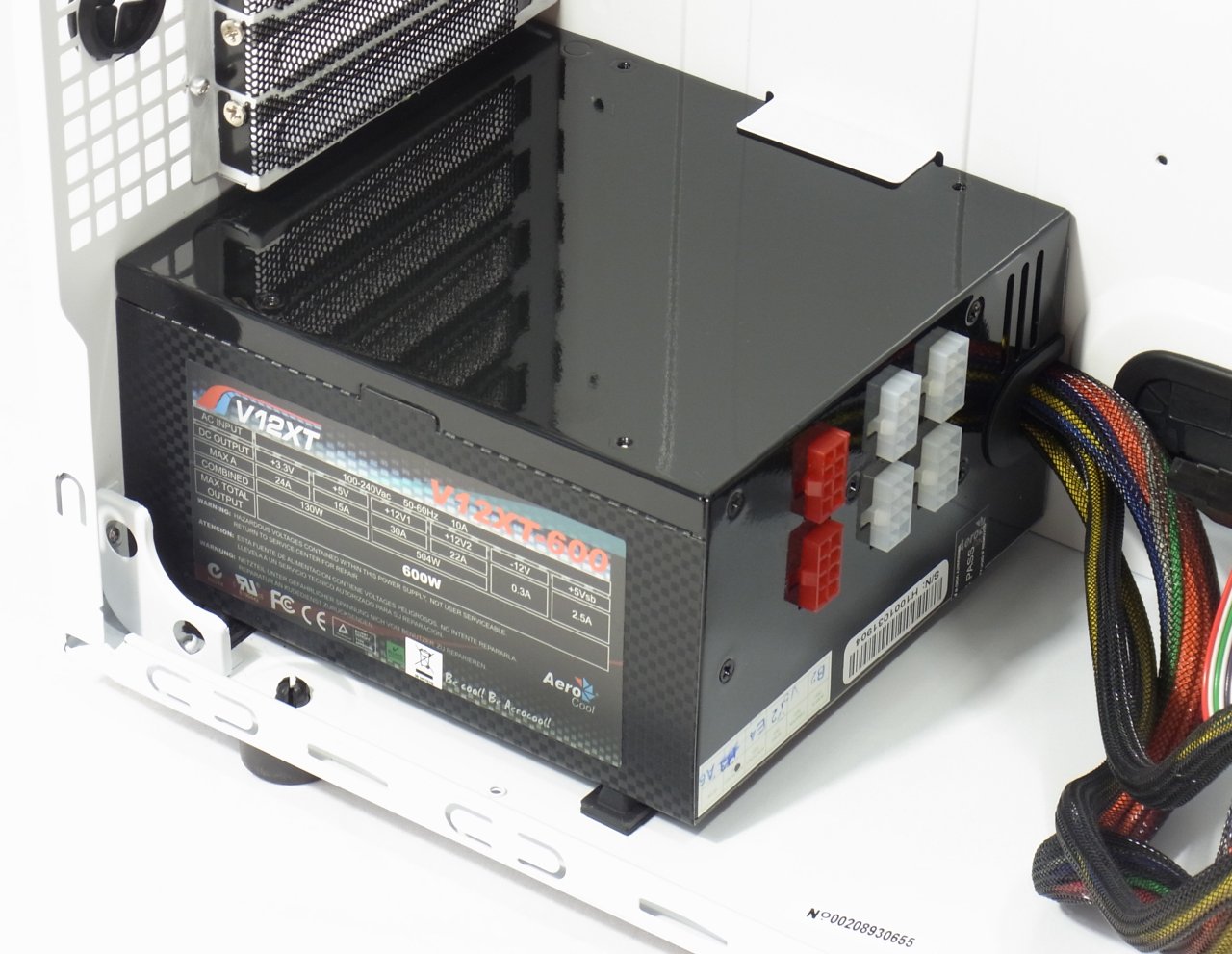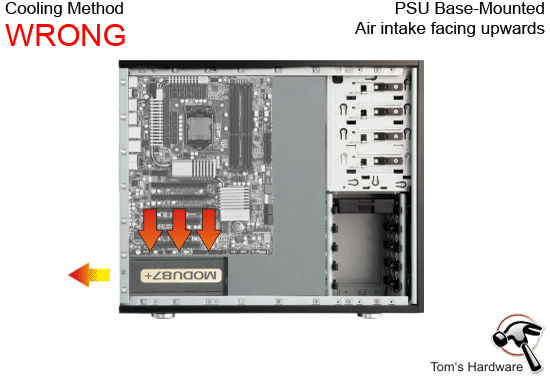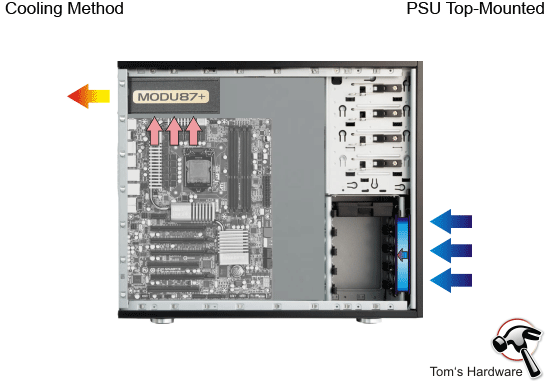How To: Properly Plan And Pick Parts For An Air-Cooled PC, Part 1
What better way to wrap up a scorching summer than with a last word on cooling? We explain the most important rules for creating ideal airflow, address the potential effectiveness of side fans, and discuss the finer points of graphics card cooling.
Power Supply: Mounting Location And Chassis Selection
PSU at the Base of the Unit
Many modern PC enclosures put the power supply down under the motherboard. This installation option has many advantages, so we strongly recommend a chassis configured this way. As you can see from the diagram, a fan sucks in cool air from the floor level through the power supply's own intake, uses it to cool active components inside the PSU, and expels it at the rear of the device.
Advantages to Bottom-Mounting:
• Steady supply of cool air from the floor outside the chassis
• Direct expulsion from the case
• Lower fan speed
• Cooler operation allows for greater PSU efficiency
• Less heat stress on the components, longer life-span
• Lower center of gravity
• No hanging power cable
Disadvantages:
• Chassis must have a bottom opening
• It should also have an air filter
• Possible impact on acoustics, depending on the floor material
Despite minor drawbacks, the above configuration is preferable to some of the other installation options that follow, and you should always look for a case that accommodates it. But it's also possible to make a mistake here:
Get Tom's Hardware's best news and in-depth reviews, straight to your inbox.
Don’t install the PSU with its opening facing up in the chassis. You should go this route only with passively-cooled "silent" PSUs, so that the warm air can rise. Otherwise, you're fighting the forces of convection, and possibly creating a situation where a screw or other loose part could fall into the power supply.
PSU at the Top of the Unit
Older PC cases manufactured according to the ATX specification put the power supply just under the case's top. Air is sucked in from inside the chassis and then expelled. Supposedly, this improves dissipation and prevents heat from building up. However, it also results in the power supply absorbing much of the waste heat generated by the graphics cards and processor. Consequently, you get inefficient operation from the PSU, whereby maximum power and efficiency are almost impossible to reach at temperatures exceeding 40°C (as they are normally based on an operating environment of around 25°C.) The longevity of components inside the power supply also suffer.
Advantages to Top-Mounting:
• Helps with cooling in some systems
• Shorter cable necessary for 12 V connections
Disadvantages:
• Higher PSU temperatures
• Inefficient and loud operation
• System ages faster
The Perfect Chassis...
...doesn’t exist. However, large, well-designed towers like the Corsair Graphite 600T come very close. There is nothing to restrict airflow inside the structure. Space, rear cable management, and lots of fans and air filters combine to create a solution that approaches what we'd consider to be ideal.
As much as possible, you should stick to enclosures that don't restrict airflow from bottom to top. If you want to include a particularly long graphics card in your configuration, employ a chassis with as much depth as possible. Otherwise, the card will split the airflow. Thick cables should always be at the rear. Also, anything that rattles around will significantly disrupt the airflow.
Current page: Power Supply: Mounting Location And Chassis Selection
Prev Page Our Test System Next Page Airflow: Install Tower Coolers Right-Side-Up
Igor Wallossek wrote a wide variety of hardware articles for Tom's Hardware, with a strong focus on technical analysis and in-depth reviews. His contributions have spanned a broad spectrum of PC components, including GPUs, CPUs, workstations, and PC builds. His insightful articles provide readers with detailed knowledge to make informed decisions in the ever-evolving tech landscape
-
compton After reading the charts of PSU placement and the GPU cooling diagrams, I'm even more convinced that my Lian Li PCA05-NB is a great solution. The motherboard is upside down, so that GPUs (In my case an axial fan gpu) faces towards the top. The CPU is now at the bottom back of the case and with the rear fan acting as an intake and not exhaust, you get great CPU cooling. The PSU mounts in the bottome front as well. The great part of this design is all the heat ends up in the top. As an option, you can vent the top to release the heat rising from the GPUs, but I like the case because it has very little venting. Through unusual case design and careful component selection I have an almost silent system - but with overclocked CPU and GPUs. The front fan is the exhaust, but has a bezel over it. With a few bucks worth of acoustic dampening material I can even hear myself think sometimes. I regard low temps and low noise output to be two sides of the same coin, but I know that many seem to not mind loud systems and mainly just care about temps. It's never been easier to build a near-silent system, even with high performance gear.Reply
If you plan ahead of time, you can make a super quiet and cool running system. It's easier to build a cool and quiet system from the start than retroactively go back and try to make a noisy (and/or hot) system quiet with great temps.
I'll be waiting for article 2. -
Mark Heath Good timing as the Australian summer approaches. You guys in the US think you have it hot :SReply -
JOSHSKORN I want my next PC to be able to play Crysis AND make me hot dogs and Iced Frappuccinos.Reply
All kidding aside...curious though, the test setup is on AMD CPUs. What about Intel CPUs? I would assume many of the concepts are similar. -
frostmachine Great guide. I live in a perpetually hot n dusty place. This will come in handy.Reply
Would be better if there's some tips on dust management. -
beetlejuicegr heh i am just showing you a pic from my pc that the airflow is totally different because there is a watercooling system on the cpu, i hope that the picture is self explanatory for all.Reply
-
amirp Hey I have a question... for the PSU you say to not put it in upside down (ie. with it's opening facing up into the chassis..) but this is how I have mine in my ANTEC300 case since there is little room between bottom of case and the PSU if mounted right-side up. So what should I do?!!Reply -
BulkZerker amirpHey I have a question... for the PSU you say to not put it in upside down (ie. with it's opening facing up into the chassis..) but this is how I have mine in my ANTEC300 case since there is little room between bottom of case and the PSU if mounted right-side up. So what should I do?!!Reply
PSU's don't pull that much air, normally. So unless your Unit kicks it's fan speed way up there then don't royy abotu it and do as suggested. If it doesn't work then you can always just flip it back to where it was.





